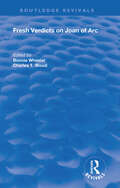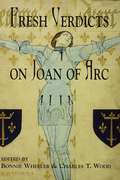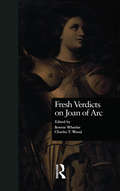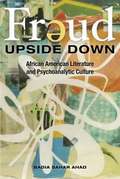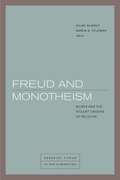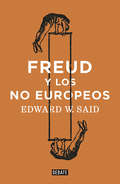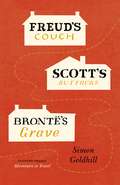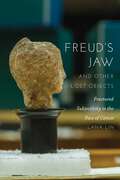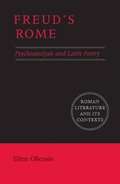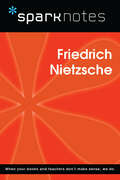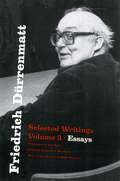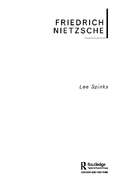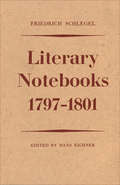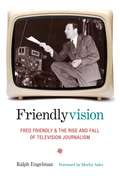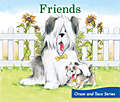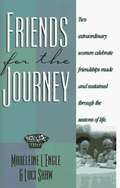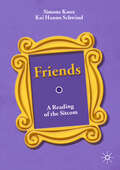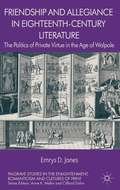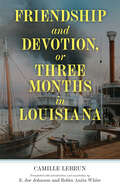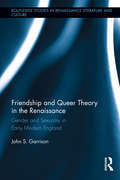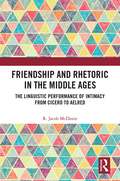- Table View
- List View
Fresh Verdicts on Joan of Arc
by Bonnie Wheeler and Charles T. WoodFirst published in 1996. This volume of original essays employs the latest tools of historical analysis, literary criticism, and feminist inquiry to reval why Joan of Arc was such an important figure.
Fresh Verdicts on Joan of Arc (New Middle Ages #Vol. 1976)
by Bonnie Wheeler Charles T. WoodThis volume of original essays employs the latest tools of historical analysis, literary criticism, and feminist inquiry to reval why Joan of Arc was such an important figure.
Fresh Verdicts on Joan of Arc (New Middle Ages #Vol. 1976)
by Bonnie Wheeler Charles T. WoodFirst published in 1996. Routledge is an imprint of Taylor & Francis, an informa company.
Freud Upside Down
by Badia Sahar AhadThis thought-provoking cultural history explores how psychoanalytic theories shaped the works of important African American literary figures. Badia Sahar Ahad details how Nella Larsen, Richard Wright, Jean Toomer, Ralph Ellison, Adrienne Kennedy, and Danzy Senna employed psychoanalytic terms and conceptual models to challenge notions of race and racism in twentieth-century America. Freud Upside Down explores the relationship between these authors and intellectuals and the psychoanalytic movement emerging in the United States over the course of the twentieth century. Examining how psychoanalysis has functioned as a cultural phenomenon within African American literary intellectual communities since the 1920s, Ahad lays out the historiography of the intersections between African American literature and psychoanalysis and considers the creative approaches of African American writers to psychological thought in their work and their personal lives.
Freud and Monotheism: Moses and the Violent Origins of Religion (Berkeley Forum in the Humanities)
by Karen S. Feldman Gilad SharvitOver the last few decades, vibrant debates regarding post-secularism have found inspiration and provocation in the works of Sigmund Freud. A new interest in the interconnection of psychoanalysis, religion and political theory has emerged, allowing Freud’s illuminating examination of the religious and mystical practices in “Obsessive Neurosis and Religious Practices,” and the exegesis of the origins of ethics in religion in Totem and Taboo, to gain currency in recent debates on modernity. In that context, the pivotal role of Freud’s masterpiece, Moses and Monotheism, is widely recognized. Freud and Monotheism brings together fundamental new contributions to discourses on Freud and Moses, as well as new research at the intersections of theology, political theory, and history in Freud’s psychoanalytic work. Highlighting the broad impact of Moses and Monotheism across the humanities, the contributors hail from such diverse disciplines as philosophy, comparative literature, cultural studies, German studies, Jewish studies and psychoanalysis.Jan Assmann and Richard Bernstein, whose books pioneered the earlier debate that initiated the Freud and Moses discourse, seize the opportunity to revisit and revise their groundbreaking work. Gabriele Schwab, Gilad Sharvit, Karen Feldman, and Yael Segalovitz engage with the idiosyncratic, eccentric and fertile nature of the book as a Spӓtstil, and explore radical interpretations of Freud’s literary practice, theory of religion and therapeutic practice. Ronald Hendel offers an alternative history for the Mosaic discourse within the biblical text, Catherine Malabou reconnects Freud’s theory of psychic phylogenesis in Moses and Monotheism to new findings in modern biology and Willi Goetschel relocates Freud in the tradition of works on history that begins with Heine, while Joel Whitebook offers important criticisms of Freud’s main argument about the advance in intellectuality that Freud attributes to Judaism.
Freud in Oz: At the Intersections of Psychoanalysis and Children’s Literature
by Kenneth B. KiddChildren&’s literature has spent decades on the psychiatrist&’s couch, submitting to psychoanalysis by scores of scholars and popular writers alike. Freud in Oz turns the tables, suggesting that psychoanalysts owe a significant and largely unacknowledged debt to books ostensibly written for children. In fact, Kenneth B. Kidd argues, children&’s literature and psychoanalysis have influenced and interacted with each other since Freud published his first case studies.In Freud in Oz, Kidd shows how psychoanalysis developed in part through its engagement with children&’s literature, which it used to articulate and dramatize its themes and methods, turning first to folklore and fairy tales, then to materials from psychoanalysis of children, and thence to children&’s literary texts, especially such classic fantasies as Peter Pan and Alice&’s Adventures in Wonderland. He traces how children&’s literature, and critical response to it, aided the popularization of psychoanalytic theory. With increasing acceptance of psychoanalysis came two new genres of children&’s literature—known today as picture books and young adult novels—that were frequently fashioned as psychological in their forms and functions.Freud in Oz offers a history of reigning theories in the study of children&’s literature and psychoanalysis, providing fresh insights on a diversity of topics, including the view that Maurice Sendak and Bruno Bettelheim can be thought of as rivals, that Sendak&’s makeover of monstrosity helped lead to the likes of the Muppets, and that &“Poohology&” is its own kind of literary criticism—serving up Winnie the Pooh as the poster bear for theorists of widely varying stripes.
Freud y los no europeos (Polirritmos Ser.)
by Edward W. SaidLa controvertida y brillante conferencia que Edward Said pronunció en el Museo Freud de Londres sobre el profundo significado que Moisés y el monoteísmo, según Freud, tienen para la política actual en Oriente Medio. Censurada y finalmente prohibida por el Instituto Freud de Viena, esta controvertida y brillante conferencia pudo ser pronunciada en el Museo Freud de Londres. Aún parecen escucharse los ecos de la inquebrantable voz de Said. El autor presenta en este ensayo una aproximación multidisciplinar, nutriéndose de fuentes procedentes de la literatura, la arqueología y la teoría social, para explorar el profundo significado que Moisés y el monoteísmo, según Sigmund Freud, tienen para la política actual en los países de Oriente Medio. El ensayo, que muestra el permanente interés de Said por la obra de Freud y la influencia de la misma en su propio trabajo, plantea que la tesis de Freud al afirmar que Moisés fue un egipcio socava la idea misma de identidad pura y mantiene que la identidad no puede pensarse ni entenderse sin el reconocimiento previo de los límites que son inherentes a ella. Said sugiere que, desde esta perspectiva, ese sentido de identidad aún no resuelto podría, de haber tomado cuerpo en la realidad política, haber formado una buena base para lograr la comprensión mutua de judíos y palestinos. En lugar de eso, la imparable marcha de Israel dirigida al establecimiento de un estado exclusivamente judío niega cualquier percepción de un pasado más complejo que incluye a ambos.
Freud's Couch Scott's Buttocks Brontë's Grave
by Simon GoldhillThe Victorian era was the high point of literary tourism. Writers such as Charles Dickens, George Eliot, and Sir Walter Scott became celebrities, and readers trekked far and wide for a glimpse of the places where their heroes wrote and thought, walked and talked. Even Shakespeare was roped in, as Victorian entrepreneurs transformed quiet Stratford-upon-Avon into a combination shrine and tourist trap. Stratford continues to lure the tourists today, as do many other sites of literary pilgrimage throughout Britain. And our modern age could have no better guide to such places than Simon Goldhill. In Freud's Couch, Scott’s Buttocks, Brontë's Grave, Goldhill makes a pilgrimage to Sir Walter Scott's baronial mansion, Wordsworth's cottage in the Lake District, the Bront ë parsonage, Shakespeare's birthplace, and Freud's office in Hampstead. Traveling, as much as possible, by methods available to Victorians—and gamely negotiating distractions ranging from broken bicycles to a flock of giggling Japanese schoolgirls—he tries to discern what our forebears were looking for at these sites, as well as what they have to say to the modern mind. What does it matter that Emily Brontë’s hidden passions burned in this specific room? What does it mean, especially now that his fame has faded, that Scott self-consciously built an extravagant castle suitable for Ivanhoe—and star-struck tourists visited it while he was still living there? Or that Freud's meticulous recreation of his Vienna office is now a meticulously preserved museum of itself? Or that Shakespeare’s birthplace features student actors declaiming snippets of his plays . . . in the garden of a house where he almost certainly never wrote a single line? Goldhill brings to these inquiries his trademark wry humor and a lifetime's engagement with literature. The result is a travel book like no other, a reminder that even today, the writing life still has the power to inspire.
Freud's Couch, Scott's Buttocks, Brontë's Grave: Adventures in Travel (Culture Trails)
by Simon GoldhillThe Victorian era was the high point of literary tourism. Writers such as Charles Dickens, George Eliot, and Sir Walter Scott became celebrities, and readers trekked far and wide for a glimpse of the places where their heroes wrote and thought, walked and talked. Even Shakespeare was roped in, as Victorian entrepreneurs transformed quiet Stratford-upon-Avon into a combination shrine and tourist trap. Stratford continues to lure the tourists today, as do many other sites of literary pilgrimage throughout Britain. And our modern age could have no better guide to such places than Simon Goldhill. In Freud's Couch, Scott’s Buttocks, Brontë's Grave, Goldhill makes a pilgrimage to Sir Walter Scott's baronial mansion, Wordsworth's cottage in the Lake District, the Bront ë parsonage, Shakespeare's birthplace, and Freud's office in Hampstead. Traveling, as much as possible, by methods available to Victorians—and gamely negotiating distractions ranging from broken bicycles to a flock of giggling Japanese schoolgirls—he tries to discern what our forebears were looking for at these sites, as well as what they have to say to the modern mind. What does it matter that Emily Brontë’s hidden passions burned in this specific room? What does it mean, especially now that his fame has faded, that Scott self-consciously built an extravagant castle suitable for Ivanhoe—and star-struck tourists visited it while he was still living there? Or that Freud's meticulous recreation of his Vienna office is now a meticulously preserved museum of itself? Or that Shakespeare’s birthplace features student actors declaiming snippets of his plays . . . in the garden of a house where he almost certainly never wrote a single line? Goldhill brings to these inquiries his trademark wry humor and a lifetime's engagement with literature. The result is a travel book like no other, a reminder that even today, the writing life still has the power to inspire.
Freud's Jaw and Other Lost Objects: Fractured Subjectivity in the Face of Cancer
by Lana LinWhat does it mean to live with life-threatening illness? How does one respond to loss? Freud’s Jaw and Other Lost Objects attempts to answer these questions and, as such, illuminates the vulnerabilities of the human body and how human beings suffer harm. In particular, it examines how cancer disrupts feelings of bodily integrity and agency. Employing psychoanalytic theory and literary analysis, Lana Lin tracks three exemplary figures, psychoanalyst Sigmund Freud, poet Audre Lorde, and literary and queer theorist Eve Kosofsky Sedgwick. Freud’s sixteen-year ordeal with a prosthetic jaw, the result of oral cancer, demonstrates the powers and failures of prosthetic objects in warding off physical and psychic fragmentation. Lorde’s life writing reveals how losing a breast to cancer is experienced as yet another attack directed toward her racially and sexually vilified body. Sedgwick’s memoir and breast cancer advice column negotiate her morbidity by disseminating a public discourse of love and pedagogy. Lin concludes with an analysis of reparative efforts at the rival Freud Museums in London and Vienna. The disassembled Freudian archive, like the subjectivities-in-dissolution upon which the book focuses, shows how the labor of integration is tethered to persistent discontinuities.Freud’s Jaw asks what are the psychic effects of surviving in proximity to one’s mortality, and it suggests that violences stemming from social, cultural, and biological environments condition the burden of such injury. Drawing on psychoanalyst Melanie Klein’s concept of “reparation,” wherein constructive forces are harnessed to repair damage to internal psychic objects, Lin proposes that the prospect of imminent destruction paradoxically incites creativity. The afflicted are obliged to devise means to reinstate, at least temporarily, their destabilized physical and psychic unity through creative, reparative projects of love and writing.
Freud’s Rome: Psychoanalysis and Latin Poetry
by Ellen OliensisThis book is a meditation on the role of psychoanalysis within Latin literary studies. Neither a sceptic nor a true believer, Oliensis adopts a pragmatic approach to her subject, emphasizing what psychoanalytic theory has to contribute to interpretation. Drawing especially on Freud's work on dreams and slips, she spotlights textual phenomena that cannot be securely anchored in any intention or psyche but that nevertheless, or for that very reason, seem fraught with meaning; the 'textual unconscious' is her name for the indefinite place from which these phenomena erupt, or which they retroactively constitute, as a kind of 'unconsciousness-effect'. The discussion is organized around three key topics in psychoanalysis - mourning, motherhood, and the origins of sexual difference - and takes the poetry of Catullus, Virgil, and Ovid as its point of reference. A brief afterword considers Freud's own witting and unwitting engagement with the idea of Rome.
Friction: An Ethnography of Global Connection
by Anna Lowenhaupt TsingA wheel turns because of its encounter with the surface of the road; spinning in the air it goes nowhere. Rubbing two sticks together produces heat and light; one stick alone is just a stick. In both cases, it is friction that produces movement, action, effect. Challenging the widespread view that globalization invariably signifies a "clash" of cultures, anthropologist Anna Tsing here develops friction in its place as a metaphor for the diverse and conflicting social interactions that make up our contemporary world. She focuses on one particular "zone of awkward engagement"--the rainforests of Indonesia--where in the 1980s and the 1990s capitalist interests increasingly reshaped the landscape not so much through corporate design as through awkward chains of legal and illegal entrepreneurs that wrested the land from previous claimants, creating resources for distant markets. In response, environmental movements arose to defend the rainforests and the communities of people who live in them. Not confined to a village, a province, or a nation, the social drama of the Indonesian rainforest includes local and national environmentalists, international science, North American investors, advocates for Brazilian rubber tappers, UN funding agencies, mountaineers, village elders, and urban students, among others--all combining in unpredictable, messy misunderstandings, but misunderstandings that sometimes work out. Providing a portfolio of methods to study global interconnections, Tsing shows how curious and creative cultural differences are in the grip of worldly encounter, and how much is overlooked in contemporary theories of the global.
Friederich Nietzsche (SparkNotes Philosophy Guide)
by SparkNotesFriederich Nietzsche (SparkNotes Philosophy Guide) Making the reading experience fun! SparkNotes Philosophy Guides are one-stop guides to the great works of philosophy–masterpieces that stand at the foundations of Western thought. Inside each Philosophy Guide you&’ll find insightful overviews of great philosophical works of the Western world.
Friedrich Dürrenmatt: Selected Writings, Volume 3, Essays
by Joel Agee Brian Evenson Friedrich Dürrenmatt Kenneth J. NorthcottThe Swiss writer Friedrich Dürrenmatt (1921–90) was one of the most important literary figures of the second half of the twentieth century. During the years of the cold war, arguably only Beckett, Camus, Sartre, and Brecht rivaled him as a presence in European letters. Yet outside Europe, this prolific author is primarily known for only one work, The Visit. With these long-awaited translations of his plays, fictions, and essays, Dürrenmatt becomes available again in all his brilliance to the English-speaking world. Dürrenmatt’s essays, gathered in this third volume of Selected Writings, are among his most impressive achievements. Their range alone is astonishing: he wrote with authority and charm about art, literature, philosophy, politics, and the theater. The selections here include Dürrenmatt’s best-known essays, such as “Theater Problems” and “Monster Essay on Justice and Law,” as well as the notes he took on a 1970 journey in America (in which he finds the United States “increasingly susceptible to every kind of fascism”). This third volume of Selected Writings also includes essays that shade into fiction, such as “The Winter War in Tibet,” a fantasy of a third world war waged in a vast subterranean labyrinth—a Plato’s Cave allegory rewritten for our own troubled times. Dürrenmatt has long been considered a great writer—but one unfairly neglected in the modern world of letters. With these elegantly conceived and expertly translated volumes, a new generation of readers will rediscover his greatest works.
Friedrich Nietzsche (Routledge Critical Thinkers)
by Lee SpinksIt is difficult to imagine a world without common sense, the distinction between truth and falsehood, the belief in some form of morality or an agreement that we are all human. But Friedrich Nietzsche did imagine such a world, and his work has become a crucial point of departure for contemporary critical theory and debate. This volume introduces this key thinker to students of literary and cultural studies, offering a lucid account of Nietzsche's thought on:* anti-humanism* good and evil* the Overman* nihilism* the Will to Power.Lee Spinks prepares readers for their first encounter with Nietzsche's most influential texts, enabling them to begin to apply his thought in studies of literature, art and contemporary culture.
Friedrich Schlegel: Literary Notebooks 1797-1801
by Hans Eichner Friedrich SchlegelSchlegel's notebooks, like those of Coleridge, are complementary to his published writings; they are repositories in which can be traced the growth and continued revision of his ideas. One hundred survived his death, more than half of which have been preserved; of the series of fifteen which deal with literature, none has hitherto been published. Dr Eichner has edited the first three of this series, covering Schlegel's most influential period, the years 1797-1801.<P><P> In these pages is to be found the only record of the theory of the Roman which he later proclaimed as the gospel of romantische Poesie, and the original versions of many of his published Fragmente. The ideas later to take shape in the Gespräch uber die Poesie are seen here in their first form. No less than in his published works, Schlegel reveals himself in these notebooks as one of the founders of modern criticism.<P> The text is given in the original German. The editor, who is Associate Professor of German at Queen's University, Ontario, has provided an introduction and an extensive commentary in English.
Friendlyvision: Fred Friendly and the Rise and Fall of Television Journalism
by Ralph EngelmanFred Friendly (1915-1998) was the single most important personality in news and public affairs programming during the first four decades of American television. Portrayed by George Clooney in the film Good Night and Good Luck, Friendly, together with Edward R. Murrow, invented the television documentary format and subsequently oversaw the birth of public television. Juggling the roles of producer, policy maker, and teacher, Friendly had an unprecedented impact on the development of CBS in its heyday, wielded extensive influence at the Ford Foundation under the presidency of McGeorge Bundy, and trained a generation of journalists at Columbia University during a tumultuous period of student revolt. Ralph Engelman's biography is the first comprehensive account of Friendly's life and work. Known as a "brilliant monster," Friendly stood at the center of television's unique response to McCarthyism, Watergate, and the Vietnam War, and the pitched battles he fought continue to resonate in the troubled world of television news. Engelman's fascinating psychological portrait explores the sources of Friendly's legendary rage and his extraordinary achievement. Drawing on private papers and interviews with colleagues, family members, and friends, Friendlyvision is the definitive story of broadcast journalism's infamous "wild man," providing a crucial perspective on the past and future character of American journalism.
Friendlyvision: Fred Friendly and the Rise and Fall of Television Journalism
by Ralph EngelmanFred Friendly (1915-1998) was the single most important personality in news and public affairs programming during the first four decades of American television. Portrayed by George Clooney in the film Good Night and Good Luck, Friendly, together with Edward R. Murrow, invented the television documentary format and subsequently oversaw the birth of public television. Juggling the roles of producer, policy maker, and teacher, Friendly had an unprecedented impact on the development of CBS in its heyday, wielded extensive influence at the Ford Foundation under the presidency of McGeorge Bundy, and trained a generation of journalists at Columbia University during a tumultuous period of student revolt.Ralph Engelman's biography is the first comprehensive account of Friendly's life and work. Known as a "brilliant monster," Friendly stood at the center of television's unique response to McCarthyism, Watergate, and the Vietnam War, and the pitched battles he fought continue to resonate in the troubled world of television news. Engelman's fascinating psychological portrait explores the sources of Friendly's legendary rage and his extraordinary achievement. Drawing on private papers and interviews with colleagues, family members, and friends, Friendlyvision is the definitive story of broadcast journalism's infamous "wild man," providing a crucial perspective on the past and future character of American journalism.
Friends (Fountas & Pinnell LLI Green #Level A, Lesson 4)
by Charlot WilsonFountas and Pinnell Leveled Literacy Intervention Books.
Friends for the Journey
by Madeleine L'Engle Luci ShawBorn of a friendship spanning a quarter of a century, Madeleine L'Engle and Luci Shaw's Friends for the Journey considers the golden quality of deep and lasting friendships, showing that the common ground of love for God transcends even separation.
Friends: A Reading of the Sitcom
by Simone Knox Kai Hanno SchwindThis book offers a long overdue, extensive study of one of the most beloved television shows: Friends. Why has this sitcom become the seminal success that it is? And how does it continue to engage viewers around the world a quarter century after its first broadcast? Featuring original interviews with key creative personnel (including co-creator Marta Kauffman and executive producer Kevin S. Bright), the book provides answers by identifying a strategy of intimacy that informs Friends’ use of humour, performance, style and set design. The authors provide fascinating analyses of some of the most well-remembered scenes—the one where Ross can’t get his leather pants back on, and Ross and Rachel’s break-up, to name just a couple—and reflect on how and why A-list guest performances sometimes fell short of the standards set by the ensemble cast. Also considered are the iconic look of Monica’s apartment as well as the programme’s much discussed politics of representation and the critical backlash it has received in recent years. An exploration of Joey, the infamous spin-off, and several attempts to adapt Friends’ successful formula across the globe, round out the discussion, with insights into mistranslated jokes and much more. For students, scholars, creative industry practitioners and fans alike, this is a compelling read that lets us glimpse behind the scenes of what has become a cultural phenomenon and semi-permanent fixture in many of our homes.
Friendship and Allegiance in Eighteenth-Century Literature
by Emrys D. JonesFriendship and Allegiance explores the concept of friendship as it was defined, contested and distorted by writers of the early eighteenth century. Setting well-known canonical texts (The Beggar's Opera, Gulliver's Travels) alongside lesser-known works, it portrays a literary world renegotiating the meaning of public and private virtue.
Friendship and Devotion, or Three Months in Louisiana (Banner Books)
by Camille LebrunParisian Pauline Guyot (1805–1886), who wrote under the nom de plume Camille Lebrun, published many novels, translations, collections of tales, and articles in French magazines of her day. Yet she has largely been forgotten by contemporary literary critics and readers. Among her works is a hitherto-untranslated 1845 French novel, Amitié et dévouement, ou Trois mois à la Louisiane, or Friendship and Devotion, or Three Months in Louisiana, a moralizing, educational travelogue meant for a young adult readership of the time. Lebrun’s novel is one of the few perspectives we have by a mid-nineteenth-century French woman writer on the matters of slavery, abolition, race relations, and white supremacy in France’s former Louisiana colony. E. Joe Johnson and Robin Anita White have recovered this work, providing a translation, an accessible introduction, extensive endnote annotations, and period illustrations. After a short preface meant to educate young readers about the geography, culture, and history of the southern reaches of the Louisiana Purchase, the novel tells the tale of two teenaged, orphaned Americans, Hortense Melvil and Valentine Arnold. The two young women, who characterize one another as “sisters,” have spent the majority of their lives in a Parisian boarding school and return to Louisiana to begin their adult lives. Almost immediately upon arrival in New Orleans, their close friendship faces existential threats: grave illness in the form of yellow fever, the prospect of marriage separating the two, and powerful discrimination in the form of racial prejudice and segregation.
Friendship and Queer Theory in the Renaissance: Gender and Sexuality in Early Modern England (Routledge Studies in Renaissance Literature and Culture #24)
by John S. GarrisonIn this volume, the author offers a substantial reconsideration of same-sex relations in the early modern period, and argues that early modern writers – rather than simply celebrating a classical friendship model based in dyadic exclusivity and a rejection of self-interest – sought to innovate on classical models for idealized friendship. This book redirects scholarly conversations regarding gender, sexuality, classical receptions, and the economic aspects of social relations in the early modern period. It points to new directions in the application of queer theory to Renaissance literature by examining group friendship as a celebrated social formation in the work of early modern writers from Shakespeare to Milton. This volume will be of interest to scholars of the early modern period in England, as well as to those interested in the intersections between literature and gender studies, economic history and the economic aspects of social relations, the classics and the classical tradition, and the history of sexuality.
Friendship and Rhetoric in the Middle Ages: The Linguistic Performance of Intimacy from Cicero to Aelred
by R. Jacob McDonieFriendship and Rhetoric in the Middle Ages: The Linguistic Performance of Intimacy from Cicero to Aelred covers approximately 1,200 years of literature. This is a book on "medieval literature" that foregrounds language as the agent for cultivating medieval friendship (from the first century BC to c. 1160 AD) in oratorical, ecclesiastical, monastic, and erotic contexts. Taking a different approach than many works in this area, which search for the lived experience of friends behind language, this book stands apart in looking at friendship's enactment through rhetorical language among classical and medieval authors.
